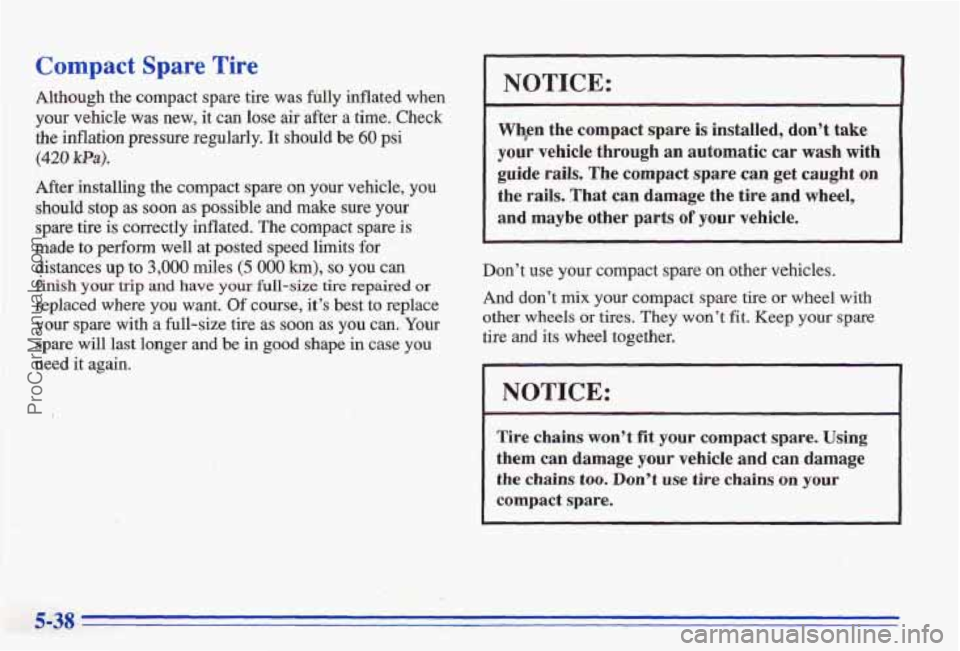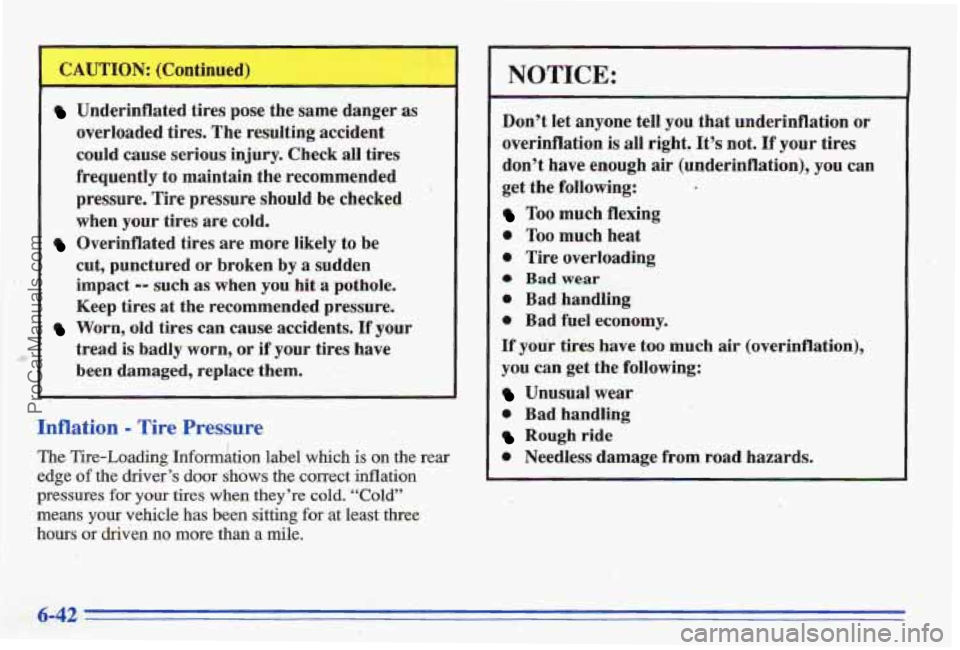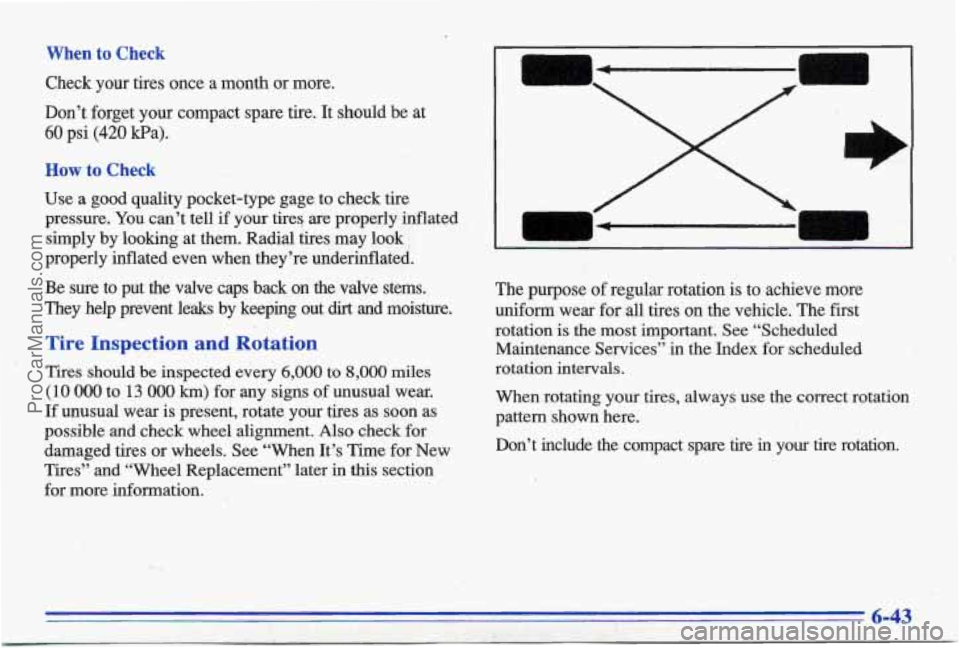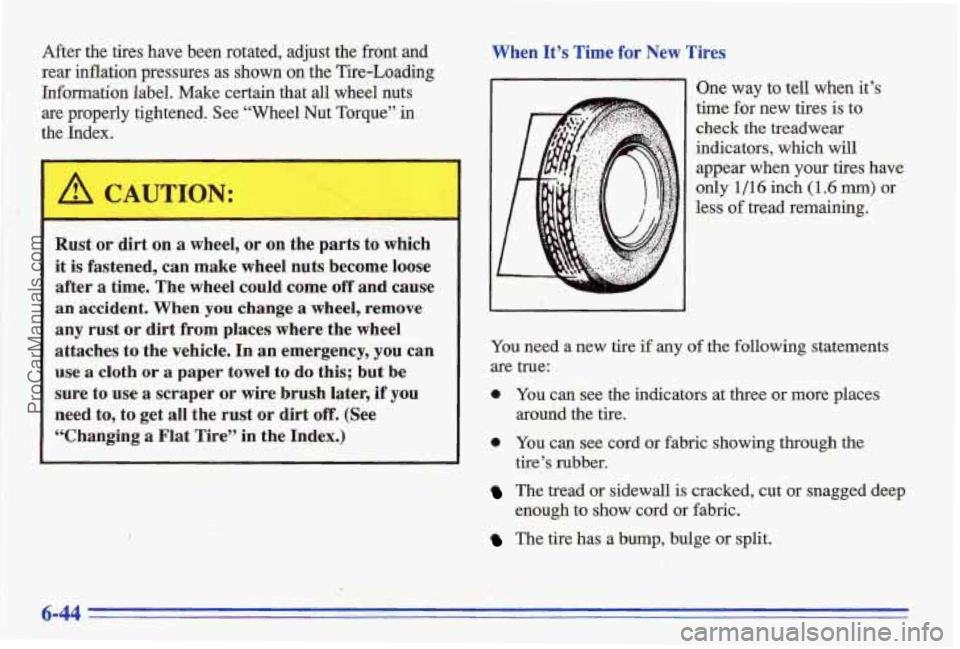Page 234 of 387
If you have aluminum
wheels with nut caps,
remove them., Removing the Flat Tire and Installing
the Spare Tire
If your have aluminum wheels and the center cover
hides the wheel nuts, remove the center cover
by using
the flat end of the wrench to pry it off. Do not drop the
cover or lay it face down, as it could become scratched
or damaged.
Do not use a hammer or mallet on this type of cover.
1. Use the wheel wrench to loosen the wheel nuts, but
don't remove them.
5-29
ProCarManuals.com
Page 235 of 387
2. Attach the wheel wrench to the jack, and rotate the '
wrench clockwise to raise the jack head a few inches.
Near each wheel well
is a notch in the frame into
which to put the jack head. The front notch is
10 inches (25 cm) back from the front wheel well.
The rear notch is 8 inches (20 cm) forward from the
rear wheel
well.
3. Position the jack and raise, the jack head until it fits
firmly on the ridge in the vehicle's frame nearest the
flat tire.
Do not raise the vehicle yet. Put the compact
spare tire near
you.
I
' !..
ProCarManuals.com
Page 236 of 387
Getting under a vehicle when it is jacked up is
dangerous. If the vehicle slips off the jack, you
could be badly injured
or killed. Never get under
a vehicle when it is supported only by a jack.
NOTICE:
Raising your vehicle with the jack improperly
positioned will damage the vehicle
or may allow
the vehicle to fall
off the jack. Be sure to fit the
jack lift head into the proper location before
raising your vehicle.
4. Raise the vehicle by rotating the wheel wrench
clockwise
in the jack. Raise the vehicle far enough
off the ground so there is enough room for the spare
tire
to fit.
S. Remove all the wheel nuts and take off the flat tire.
5.-31
ProCarManuals.com
Page 241 of 387
Storing the Flat Tire and Tools
Storing a jack, a tire or other equipment in the
passenger compartment
of the vehicle could
cause injury. In
a sudden stop or collision, loose
equipment could strike someone. Store all these
in the proper place.
After you’ve put the compact spare tire on your vehicle,
you’ll need
to store the flat tire in your trunk. Use the
following procedure to secure the flat tire in the trunk.
Store the flat tire as far forward in the trunk as possible.
Store the jack and wheel wrench
in their box in the trunk
on the passenger’s side.
5-36 ,
ProCarManuals.com
Page 243 of 387

Compact Spare Tire
Although the compact spare tire was frilly inflated when
your vehicle was new, it can lose air after a time. Check
the inflation pressure regularly. It should be.60 psi
After installing the compact spare can your vehicle, you
should stop as soon as possible and make sure
your
spare tire is correctly inflated. The compact spare is
made to perfom well at posted speed
limits for
distances up
to 3,000 miles (5 000 km), so YOU can
f~sh your trip and have your full-size tire repaired or
replaced where you want. Of course, it’s best to replace
your spare with a full-size tire as soon as you can. Your
spare
will last longer and be in good shape in case you
need it again.
(420 Wa).
NOTICE:
Whpn the compact spare is installed, don’t take
your vehicle through an automatic car wash with
guide rails.
The compact spare can get caught on
the rails. That can damage the tire and wheel,
and maybe other parts
of your vehicle.
Don’t use your compact spare
on other vehicles.
And don’t
mix your compact spare tire or wheel with
other wheels or tires. They won’t fit. Keep your spare
tire and its wheel together.
NOTICE:
Tire chains won’t fit your compact spare. Using
them can damage your vehicle and can damage
the chains
too. Don’t use tire chains on your
compact spare.
ProCarManuals.com
Page 287 of 387

Underinflated tires pose the same danger as
overloaded tires. The resulting accident
could cause serious injury. Check all tires
frequently to maintain the recommended
pressure. Tire pressure should be ch’ecked
when your tires are cold.
cut, punctured or broken
by a sudden
impact
-- such as when you hit a pothole.
Keep tires at the recommended pressure.
Worn, old tires can cause accidents. If your
tread is badly
worn, or if your tires have
been damaged, replace
them.
Overinflated tires are more likely to be
Inflation - Tire Pressure
The Tire-Loading Informkion label which is on the rear
edge of the driver’s door shows the correct inflation
pressur,es
for yow tires when they’re cold. “Cold”
means your vehicle has been sitting for at least three
hours
or driven no more than a mile.
NOTICE:
Don’t let anyone tell you that underinflation or
overinflation is all right. It’s not. If your tires
don’t have enough air (underinflation),
you can
get the following:
Too much flexing
0 Too much heat
0 Tire overloading
@ Badwear
0 Bad handling
0 Bad fuel economy.
If your tires have too much air (overinflation),
you
can get the following:
Unusual wear
0 Bad handling
Rough ride
0 Needless damage from road hazards.
ProCarManuals.com
Page 288 of 387

When to Check
Check your tires once a month or more.
Don’t forget your compact spare tire. It should be at
60 psi (420 kPa).
How to Check
Use a good quality pocket-type gage to check tire
pressure. You can’t tell
if your tires are properly inflated
simply by looking at them. Radial tires may look
~
properly inflated even when they’re underinflated.
Be sure to put the valve caps back on the valve stems.
They help prevent l&s by keeping out
dirt and moisture.
Tire Inspection and Rotation
Tires should be inspected every 6,000 to 8,000 miles
(10 000 to 13 000 km) for any signs of unusual wear.
If unusual -wear
is present, rotate your tires as soon as
possible and check wheel alignment.
Also check for
damaged tires or wheels. See “When It’s Time for Ne,w
Tires” and “Wheel Replacement” later in
this section
for more information. The purpose
of regular rotation is to achieve more
uniform wear for all tires
on the vehicle. The first
rotation is the most
important. See “Scheduled
Maintenance Services”
in the Index for scheduled
rotation
intervals.
When rotating your tires, always use the correct rotation
pattern shown here.
Don’t include the compact spare tire
in your tire rotation.
,. .
ProCarManuals.com
Page 289 of 387

After the tires have been rotated, adjust the front and
rear inflation pressures as shown
on the Tire-Loading
Infannation label. Make certain that all wheel nuts
are properly tightened. See “Wheel Nut Torque”
in
the Index.
I --I
Rust or dirt on a wheel, or on the pads to which
it is fastened, can make wheel nuts become loose
after
a time. The wheel could come off and cause
an accident. When you change a wheel, remove
any rust or dirt from places where the wheel
attaches
to the vehicle. In an emergency, you can
use
a cloth or a paper towel to do this; but be
sure to use
a scraper or wire brush later, if you
need
to, to get all the rust or dirt off. (See
“Changing a Flat Tire” in the Index.) When
It’s Time for New Tires
One
way to tell when it’s
time for new tires
is to
check the treadwear
indicators, which will
appear when your tires have
only 1/16 inch (1.6 rnm) or
less
of tread remaining.
YOU need a new tire if any of the following statements
are true:
0 YOU can see the indicators at three or more places
around the tire.
0 you can see cord or fabric showing through the
tire’s rubber.
The tread or sidewall is cracked, cut or snagged deep
enough to show cord
or fabric.
The tire has a bump, bulge OT split.
6-44
ProCarManuals.com